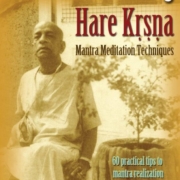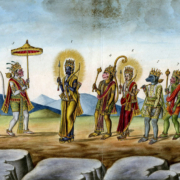How to Chant Mantras? – part two
By Mahanidhi Swami
Now we will discuss physical posture and its effect on chanting success. Yoga mantra sastras recommend that one should sit perfectly still (no shaking the head or pacing back and forth) with a straight back, because an upright posture keeps the nerves peaceful and aids concentration. Krishna gives the same instruction in the Bhagavad-gita verse 6.13: “One should hold one’s body, neck and head erect in a straight line and stare steadily at the tip of the nose.”
“Without moving the lips or tongue, shaking the head or neck, or showing the teeth, one should meditate on the syllables of the mantra, the meaning of each word, and the meaning of the whole mantra. Without knowing its meaning, one will not attain the goal intended by chanting that mantra.” (Yajnavalkya-smrti)
In summary, one should not move his lips, tongue or shows the teeth. One should close his eyes. Then chant silently in the mind while being deeply absorbed in the meaning of each word and the meaning of the complete mantra. Regarding the point of not moving the tongue, some yoga books claim that concentration is enhanced by holding the tongue firmly against the roof of the mouth while chanting the mantras within the mind.
One yogi said, “This helps circulate the prana by acting as a bridge between the head and the circuit on the front of the body. When doing so your aura automatically becomes brighter. If you add breath control, the aura becomes even brighter. So it would be good for health, mind and spirit.”
Of course, a program of yoga and pranayama for health is not the objective, but the principle is to do whatever works to fix the mind on Krishna and never forget Him. If one cannot concentrate while chanting silently in the mind, however, then one may move the lips slightly while inaudibly mouthing the words of the Gayatri.
Srila Sanatana Goswamipada gives some very particular instructions regarding mantras: “When chanting Gayatri japa the sadhaka should not move his head and neck about, nor show his teeth. He shall sanctify his mind by withdrawing it from the objects of the senses, and by silently meditating upon the meaning of the mantra. If the mantra remains within the mind, and the mind remains within the mantra (in other words—the mind and mantra are joined), then the characteristics of Gayatri japa are revealed to the chanter. While performing japa, the fingers must be kept together and slightly contracted at the base. If the fingers are separated, the effect of the japa will leak out through the spaces.” (HBV 17th vilasa)
Even though many physical suggestions are given herein, the mind is the main factor in successful Gayatri chanting. Perfection comes from intense meditation, not sitting postures. Meditation means deeply concentrating on Krishna who appears in the form of the mantra (mantra-rupa). The sadhaka must focus all his mental and intellectual energy on the mantra until it reveals its secrets. Lord Brahma, for example, focused on the Gopala-mantra until it fully bloomed within his consciousness. Meditation is the art of communion with Krishna after searching Him out in the dark core of the heart.
To avoid sleepiness and to attain maximum concentration one can sit in the siddhasana or the padmasana, which Lord Brahma used while chanting the Gopala-mantra. “Thus while sitting and chanting one may keep his body straight, and this will help one in the chanting process; otherwise one may feel sleepy.” (SB 7.15.31 p.)
Padmasana— First sit on the floor on a seat made of kusa grass, wool or silk. Hold the right- foot and place it on top of the left thigh with the outer edge of the foot pressed into the groin. Bring the right knee in to face almost forward. Lift the left foot over the right thigh, and bring it into the right groin. Move the feet further up into the groin and bring the knees closer together. Sit straight, extending the trunk up. Open the chest, and move the shoulder blades in. Lift the diaphragm up and relax the face.
If one cannot do asanas or sit up straight, then sit against a wall or in a firm chair. One should sit perfectly still, breathe slowly and deeply, keep the mouth closed, and the tongue still. Fixing the mind on Sri Guru, Sriman Mahaprabhu, and the lotus feet of Radha and Krishna or a personal ista-deva, begin chanting with total absorption, feeling, and surrender. Meditate deeply on the meaning of each word and on the conception of the whole mantra.
(Excerpt from Gayatri Mahima Madhuri by Mahanidhi Swami)
Asana pranayama and mantra dhyana ki jai!
Jai Jai Sri Radhe!






Leave a Reply
Want to join the discussion?Feel free to contribute!